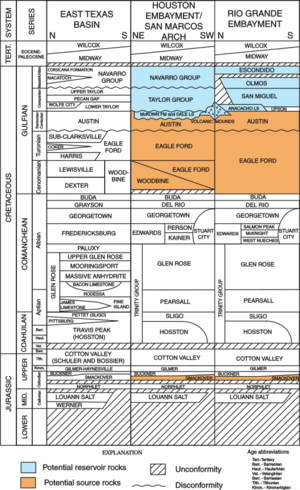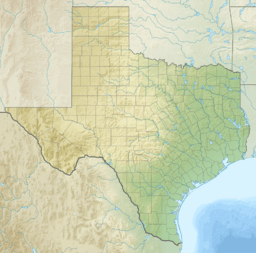Pilot Knob (Austin, Texas) facts for kids
Quick facts for kids Pilot Knob |
|
|---|---|

Pilot Knob rises out of the lowlands west of Cottonmouth Creek
|
|
| Highest point | |
| Geography | |
| Topo map | USGS |
| Geology | |
| Age of rock | late–Cretaceous Period |
| Volcanic arc/belt | Ouachita |
| Last eruption | 79–83 million years ago |
Pilot Knob is what's left of an extinct volcano located about 8 miles (13 km) south of downtown Austin, Texas. It's close to the Austin-Bergstrom International Airport and McKinney Falls State Park.
Contents
What is Pilot Knob?
Pilot Knob is one of about 75 ancient volcanoes found across Central Texas. These volcanoes are spread out from Waco to Austin, San Antonio, and Del Rio. All of them have been inactive for millions of years.
The Pilot Knob area has four small, rounded hills. These hills form the main part of the volcano's core, covering an area about two miles (3.2 km) wide. The hills are made of a tough, dark volcanic rock called trap rock. This rock is very strong and resists being worn away by weather.
The volcano's core rises above a flat area called a lowland. This lowland is drained by Cottonmouth Creek. It's mostly made of volcanic ash and other rocky bits that exploded from the volcano. Around this lowland, there's a ring of sedimentary rock. This rock was formed from ancient beach sediments, like shell pieces and volcanic ash, that settled in the shallow sea around the volcano.
How Did Pilot Knob Form?
Millions of years ago, during the late Cretaceous Period, Central Texas was covered by a shallow sea. The land slowly sank as layers of carbonate rocks were laid down.
The Explosive Start
The Pilot Knob volcano began when hot magma from deep underground pushed its way up. When this magma hit water-filled sediments near the surface, the water quickly turned into steam. This caused a huge explosion, creating a large crater. More explosions happened as new magma met more water in the volcanic ash.
Over time, a cone of ash built up over the explosion crater. Ash eruptions continued until the mound grew above the sea's surface. We know this because layers of ash, now turned into clay, are found mixed with limestone and marl around Pilot Knob. These layers show that the volcano erupted above water.
Lava Flows and Mudslides
As the ash cone grew, its slopes became unstable on the seafloor. This led to large mudflows of ash and carbonate mud. These mudflows sometimes tore up the layers of mud below them.
Later, as the volcano grew above the sea, magma could push into the ash mound without touching seawater. This led to calmer lava eruptions. This lava cooled and hardened, forming the tough trap rock that makes up the core of Pilot Knob today. Some of these trap rock areas are what's left of ancient lava flows.
After the Eruptions
When the volcano became less active, beaches formed around it. One of these ancient beach deposits, now a hard rock, stretches for miles north of the volcano. You can see it along Onion Creek, where it forms both the Upper and Lower McKinney Falls.
After the volcano stopped erupting, the whole area continued to sink. Layers of mud from the Taylor Group covered the entire volcano. Much later, during the Tertiary era, Central Texas was lifted up. This caused the younger sedimentary rocks to wear away, revealing the ancient volcano. Today, the landscape around Pilot Knob shows how different types of rock resist erosion differently.
How Do We Know Its Age?
Scientists have used two main ways to figure out when Pilot Knob erupted. One way is by studying the layers of rock and the fossils found in them. The other way is by using special dating methods on the volcanic rocks themselves. Both methods give similar results, which helps scientists be more sure about the age.
Dating with Rock Layers and Fossils

The Pilot Knob volcano greatly affected the layers of rock in the Austin area. The eruptions happened when the upper parts of the Dessau and Burditt formations of the Austin Chalk were forming. These rock layers are much thinner near Pilot Knob than in other places around Austin. This is because the volcano was active there.
Scientists can also find specific fossils that are common in certain layers. These "faunal zones" are also squeezed together near Pilot Knob. Two layers of altered ash are found within the Dessau Formation near Pilot Knob. The ancient beach rock north of Pilot Knob is now called the McKown Formation. Because the volcanic activity happened during the formation of the Dessau and Burditt layers, scientists can tell that Pilot Knob erupted between 83 and 79 million years ago. This time period is known as the Lower Campanian age.
Dating with Radioactive Elements
Scientists also used a method called potassium-argon dating to find the age of Pilot Knob. This method works by measuring how much radioactive potassium (potassium 40) has changed into argon gas (argon 40) inside the rocks. Since scientists know how fast this change happens, they can calculate the rock's age.
Using this method, the age of Pilot Knob's eruptions was found to be about 79.5 million years, plus or minus 3 million years. This age matches very well with the age found by studying the rock layers and fossils.
Where Did the Magma Come From?
The rocks from Pilot Knob are still being studied closely. However, similar rocks from volcanoes near Uvalde, Texas, which are about the same age, have been studied. Both Pilot Knob and the Uvalde volcanoes are part of a chain of volcanic areas. This chain runs along a hidden ancient mountain range called the Ouachita structural belt in Central and South Texas. This belt might have been a weak spot in the Earth's crust, allowing magma to rise from deep below.
Scientists believe the magma came from the Earth's upper mantle. This is the layer of hot, semi-solid rock beneath the crust. The magma formed when parts of the mantle rocks melted.
Two types of magma are thought to have formed. One type was basaltic, containing minerals like plagioclase, pyroxene, and olivine. The other type formed minerals like nepheline, melilite, and pyroxene. Some rocks even contain pieces of the upper mantle, called spinel peridotite. This suggests that these mantle fragments were carried up by the magma as it rose.
At Pilot Knob, only rocks from the second type of magma have been found. No basaltic rocks have been located. While no direct mantle fragments have been found in Pilot Knob rocks, scientists suspect they might be there. Some of the olivine crystals in the rocks could be pieces from the upper mantle.
How to Visit Pilot Knob
You can see Pilot Knob by driving south of Austin on Highway 183. Drive past the Austin-Bergstrom International Airport. The hill will be visible on your right after you cross Onion Creek.
You can drive around the volcanic area by turning right off Highway 183 onto Dee Gabriel Collins Road. Head west until you reach McKinney Falls Parkway. Turn left and follow the Parkway to Colton Bluff Springs Road. A left turn there will lead you back to Highway 183.
Dee Gabriel Collins Road follows the northern edge of the volcano's ancient beach rock. To the south of this road, you can easily see the lowland drained by Cottonmouth Creek. This area is made of soft volcanic ash that wears away easily. The central core, made of tough trap rock, is also visible. About two-thirds of a mile (1 km) east of the intersection of Bluff Springs Road and McKinney Falls Parkway, you can see the trap rock of south Pilot Knob along the road. This rock is very similar to the rock at the center of the volcano. It might be what's left of a lava flow that erupted from the volcano's side.
It's important to know that most of the Pilot Knob volcano is on private land. Only the road margins are accessible to the public.
Pilot Knob in Pop Culture
Pilot Knob was featured in the second season of the TV show 9-1-1: Lone Star. In the show, the volcano became active again. The characters had to try and save lives during the eruption.


